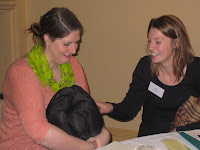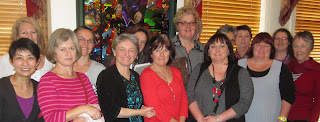I look out over a sea of friendly, Australian faces, and I wonder: "Is the room too small for all these participants? Can they hear me in the back? How will I engage the ones in the corner or on that last row? And why did over 300 professionals show up for HUG Your Baby workshops, a program that is new to Australia?"
Barb has a reputation for bringing to Australia leaders in the birth, breastfeeding and early parenting fields, including such notables as: Dr. Nils Bergman, Dr. William Sears, Gloria Lemay, Rachel Reed, Bridget Ingle and Alison Stuebe. Needless to say, I was delighted that Barb hooked The HUG car onto her might train! She arranged HUG Your Baby trainings in Hobart, Melbourne and Sydney. And as one participant told me, "If Barb says this one is worth seeing, I show up!"

However, many well established midwifery practices in Australia permit a woman to be followed exclusively by her midwife team, who provide all her prenatal, labor and delivery, and postpartum care (sometimes requiring an additional co-pay). These patients are typically discharged from the birth center or hospital in about 12 hours and receive once- or twice-daily home visits, as needed, for up to two weeks. That's how childbirth works in Australia.
 The third answer may lie in Australia's exceptional home visiting program. Barb explains that in the state of Victoria all Maternal Child Health Nurse home visitors are midwives with birth experience and further pediatric training. These nurses usually have the authority to assess a family's needs and to continue making home visits, as necessary, for a number of weeks. Employed by local councils and the Dept of Education and Early Childhood, MCH nurses staff follow-up clinics where routine well-child care is provided on a schedule similar to what is the case in the US (visits at 2, 4, 6, and 8-weeks; 4, 8, 12, and 18-months; 2 and 3.5 years). Maternal Child Health Nurses know firsthand what worries new "mums" and dads, and they actively seek out appropriate continuing education, which is generously paid for by their state.
The third answer may lie in Australia's exceptional home visiting program. Barb explains that in the state of Victoria all Maternal Child Health Nurse home visitors are midwives with birth experience and further pediatric training. These nurses usually have the authority to assess a family's needs and to continue making home visits, as necessary, for a number of weeks. Employed by local councils and the Dept of Education and Early Childhood, MCH nurses staff follow-up clinics where routine well-child care is provided on a schedule similar to what is the case in the US (visits at 2, 4, 6, and 8-weeks; 4, 8, 12, and 18-months; 2 and 3.5 years). Maternal Child Health Nurses know firsthand what worries new "mums" and dads, and they actively seek out appropriate continuing education, which is generously paid for by their state.+2.jpeg)
In other Australian states Child Health Nurses are not necessarily midwives, but they provide similar care. Some of these nurses shared with me that their focus is on high-risk mothers and that they are often not given the time to make as many home visits as they think would be important for this population. In addition, they are not available to non-high-risk "mums," who may have economic advantages but still have significant needs.
Barb shares a final answer to my question about the positive response to my workshops by explaining that interest in the HUG Your Baby workshops may reflect a mounting dissatisfaction, on the part of many nurses, with the widely held practice of teaching parents "controlled crying." (See the HUG blog for more details on Australian "sleep schools" for babies.) "Nurses are looking for alternative ideas on how to calm a fussy baby and help a baby sleep better," Barb explains.
Though the reasons for the success of HUG teaching in Australia may be understandable, "Startling!" "Mind-blowing!" and "Close to overwhelming!" are words I hear from Barb as she sorts out slews of name tags and welcomes hordes of experienced professionals to the Australian HUG Your Baby teaching tour.
Our Hobart workshop is a comfortable size of thirty professionals who share their curiosity about HUG Your Baby, their humor with role playing, and their passion for the babies they serve. (Watch this YouTube video of a Hobart midwife describing what she learned at the HUG workshop she attended.)
As the Melbourne workshop overflows, Barb decides to offer an additional session there. The "overflow" Melbourne workshop (photo) is again a more typical workshop format, with time for interactive games, sharing of stories, and role playing.
However, the larger Melbourne gathering of nearly 200 necessitates a shift in my teaching style to more of a lecture format. But after I spend time reading up on successful "large scale teaching" and consulting with my educational mentors, Linda Belans (via Sykpe) and my husband Jim (over coffee), I discover that I can still integrate time for reflecting on one's practice, "share with a neighbor" exercises, and enthusiastic story-telling and video case studies into a more formal, lecture format.
The 80+ Sydney participants receive a similar large-scale format, though here I find that I am able to squeeze myself between packed rows of chairs to engage an unsuspecting nurse about her experiences with babies or her personal reactions to the HUG concepts.
My favorite moment of the day is when a nurse asks what to do with a disengaged mother who is more interested in a cell phone than the baby before her. Of course, I invite this nurse to role play this mother--a job she does with zest, humor, and impressive, real-life, challenging behavior. But, as I anticipate, the HUG Strategies come through. This disengaged mother and her audience of nurses familiar with this scenario agree that they are won over by the power of these HUG Strategies: "Starting Here not There," "Seeing and Sharing," and "Gaze and Engaging."
Feedback from the Australian HUG workshop participants is VERY positive. They liked "getting a HUG!" Now I am scrambling to line up previously Certified HUG Teachers to be the "HUG buddy" for the over 80 experienced nurses and midwives who signed up to complete the Certified HUG Teacher program. (Click HERE to see Australian HUG workshop evaluations.)
Over dinner and a much-deserved glass of Australian wine in stunning Sydney Harbor, Barb wonders when HUG Your Baby will make its next Australian tour. With big smiles on our (somewhat exhausted) faces, Jim and I promise to return. But tonight, we finish our tasty wine and fresh Australian scallops (we passed on the "bug," a local lobster-like creatures), and then settle in for a good night's sleep as we prepare to move on to Indonesia, new baby and childbirth experiences there, and a few weeks of R and R in Bali!
.



+2.jpeg)





